Welcome to a vibrant journey through the fascinating world of Mexican drinks! If there’s one thing that captures the essence of Mexican culture, it’s the nation’s love affair with beverages that range from the time-honored to the innovative. The diversity of Mexican drinks is like a kaleidoscope of flavors, representing a rich history shaped by Indigenous roots, Spanish influences, and modern twists. It’s not just about quenching thirst; it’s about celebrating life, family, and traditions that date back centuries.
From the spirited kick of tequila in a zesty Margarita to the soothing touch of corn in a warm cup of Atole, Mexican drinks offer something for everyone. Whether you’re raising a glass of Mexican sparkling wine to toast to a celebration or sipping an icy horchata on a hot afternoon, you’re partaking in a ritual that is as Mexican as mariachi music and Lucha Libre. So on your next trip, lets us help you decide what to drink in Mexico.
Contents
- Must-Try Mexican Beer, Wine and Spirits
- Delicious Must-Try Non-Alcoholic Mexican Drinks
- So now you know what to drink in Mexico!
Must-Try Mexican Beer, Wine and Spirits
In this comprehensive guide, we are going to delve deep into the 51 most popular Mexican drinks that embody the soul of Mexico—a medley of alcoholic and non-alcoholic options that will make you feel like you’re wandering through a bustling Mexican mercado or sitting at a family fiesta. From tequila-based cocktails to comforting hot beverages, from succulent fruit juices to regional specialties, our list offer a fiesta of flavors waiting to be explored.
So, prepare your taste buds for an incredible experience as we explore the culinary treasure that is Mexican drinks. Whether you’re a connoisseur looking for your next favorite cocktail, a traveler eager to immerse yourself in Mexican culture, or simply curious about the beverages that make Mexican cuisine so irresistibly unique, you’re in for a treat. Salud!
Mexico´s Agave-Based Spirits and Popular Cocktails
Tequila
Tequila is not just an agave-based spirit; it’s a symbol of Mexico’s rich cultural and agricultural heritage. Derived from the blue agave plant primarily grown in the state of Jalisco, Tequila’s roots dig deep into ancient Mesoamerican civilizations, where agave was revered both spiritually and practically. The meticulous process of crafting tequila, from harvesting the “piña” (heart) of the agave to its fermentation and distillation, has been refined over centuries, resulting in a drink that encapsulates the essence of the Mexican terroir.
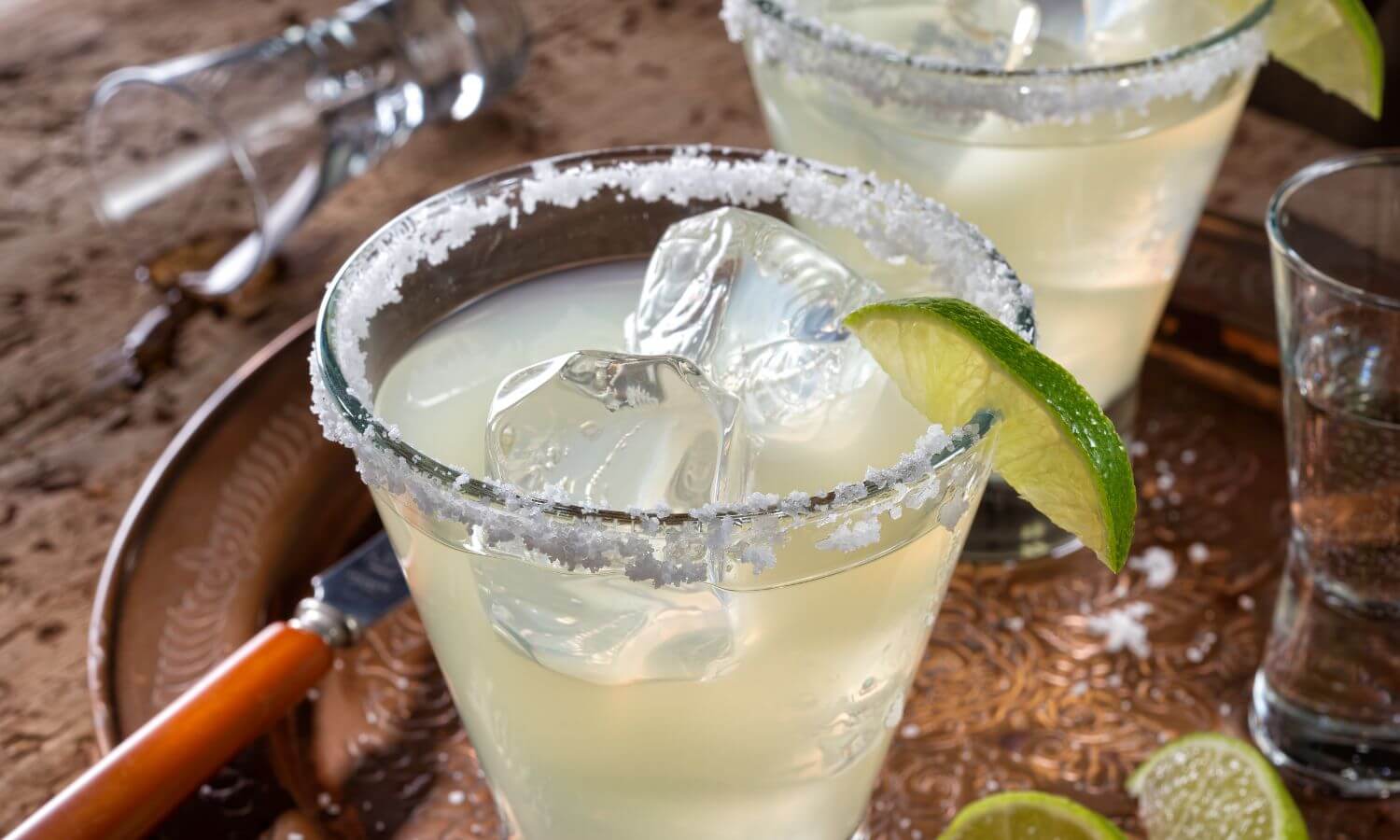
Tequila’s quintessential Mexican identity is cemented by its Denomination of Origin, meaning true tequila can only be produced in specific regions of Mexico. This not only preserves its authenticity but also celebrates the unique climatic and geological conditions that give tequila its distinct flavor profile. Whether sipped neat in a caballito accompanied by sangrita or mixed to make the iconic Margarita, Tequila stands as a testament to Mexico’s ability to transform a native plant into a world-renowned spirit. Its deep cultural significance, combined with its bold and diverse flavors, makes tequila a proud embodiment of the Mexican spirit.
Popular Tequila Drinks
Margarita
The classic Margarita is a timeless cocktail that encapsulates the vibrant spirit of Mexico. Traditionally made with just three primary ingredients: tequila, fresh lime juice, and an orange liqueur like Cointreau or Triple Cec, this drink is a harmonious blend of sweet, sour, salty, and bitter.

Variations of the Margarita have emerged over the years, catering to diverse palates. Some versions incorporate fruits like strawberries, mangoes, or pineapples for a fruity twist. Others might introduce spicy elements, such as jalapeño or habanero peppers. It can be served on the rocks, blended for a frozen treat, or even straight up without ice.
Paloma
One of the most popular Mexican cocktails is the Paloma. Traditionally, a Paloma cocktail is made with white tequila and grapefruit soda like Jarritos de Toronja, Fresca or Squirt. If you don´t have grapefruit-flavored soda, you can also make a delicious Paloma cocktail with grapefruit juice and sparkling water. Served in a glass with lots of ice and garnished with a lime wedge, a Paloma is the perfect drink for a warm day.
Tequila Sunrise
The Tequila Sunrise is one of the best-known traditional Mexican drinks. Its name is derived from the beautiful gradient created by its ingredients which mimic the hues of a sunrise.. A Tequila Sunrise is a simple concoction of tequila blanco, fresh orange juice, and grenadine.
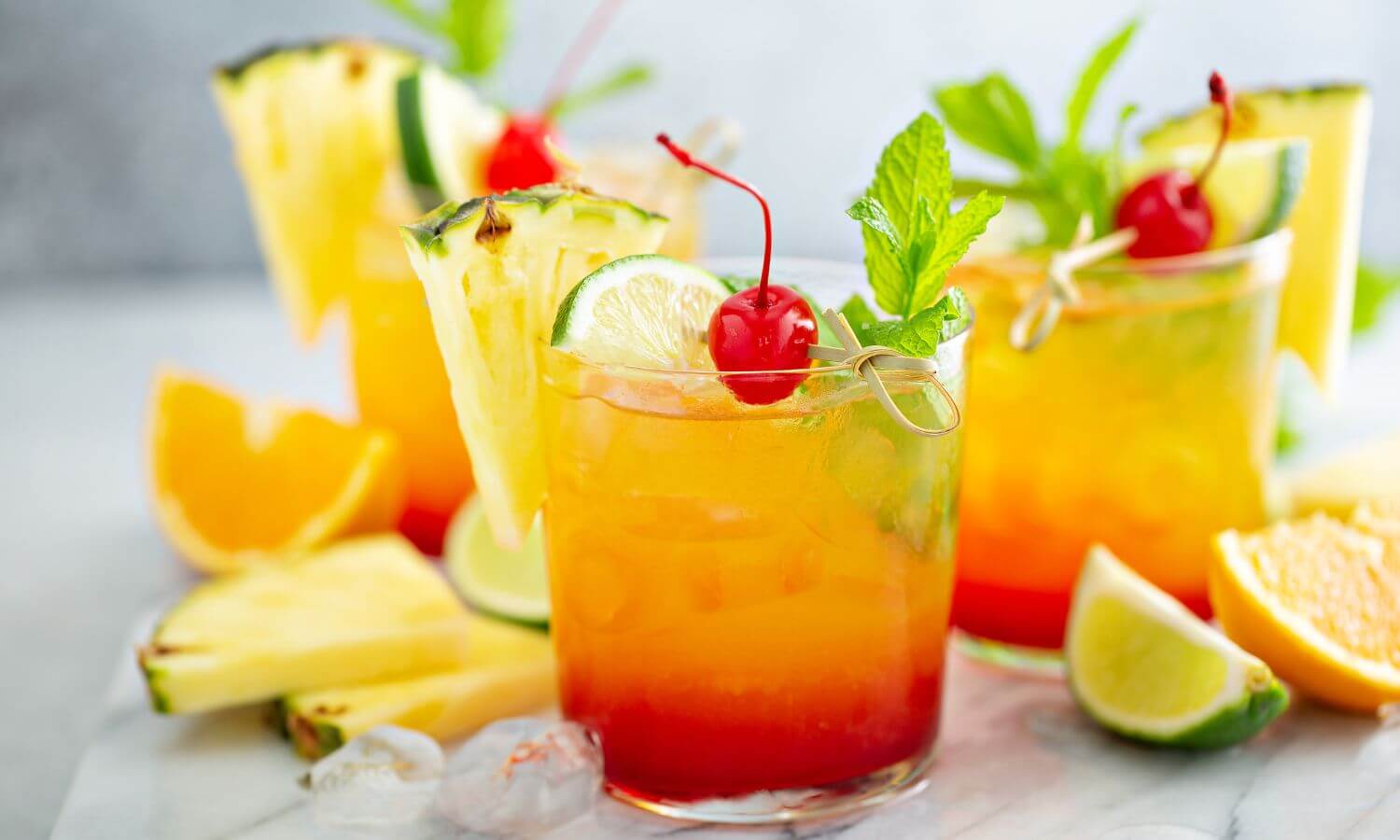
To make it, pour 2 ounces of tequila and 4 ounces of orange juice into a glass filled with ice. To finish the drink, slowly drizzle grenadine down the side, allowing it to settle at the bottom. When properly executed, the result is a radiant display of oranges and reds, which evoke memories of late afternoons on the beach in Mexico.
Vampiro Drink (Vampiros Mexicanos)
The Vampiro is a popular Mexican cocktail that combines the bold flavors of tequila with the richness of tomato and citrus juices. Its name, which literally means “vampire” in Spanish, is attributed to its deep red hue, reminiscent of the infamous creature’s famed drink of choice.
Not to be confused with a Bloody Maria which is nothing more than a traditional Bloody Mary made with tequila, the defining ingredient in a Vampiro is sangrita – a spicy and tangy blend of tomato juice, orange juice, lime juice, a dash of hot sauce and grenadine for color. Some bartenders prepare a Vampiro cocktail with a splash of grapefruit soda to add a bit of sweetness and fizz.
Cantarito
The Cantarito is a refreshing Mexican cocktail made from a blend of tequila, lime juice, grapefruit soda, and a splash of orange juice, typically served in a clay mug known as a “jarrito.” Originating from the state of Jalisco, the home of tequila, this drink is a citrusy delight that’s both tangy and slightly sweet.
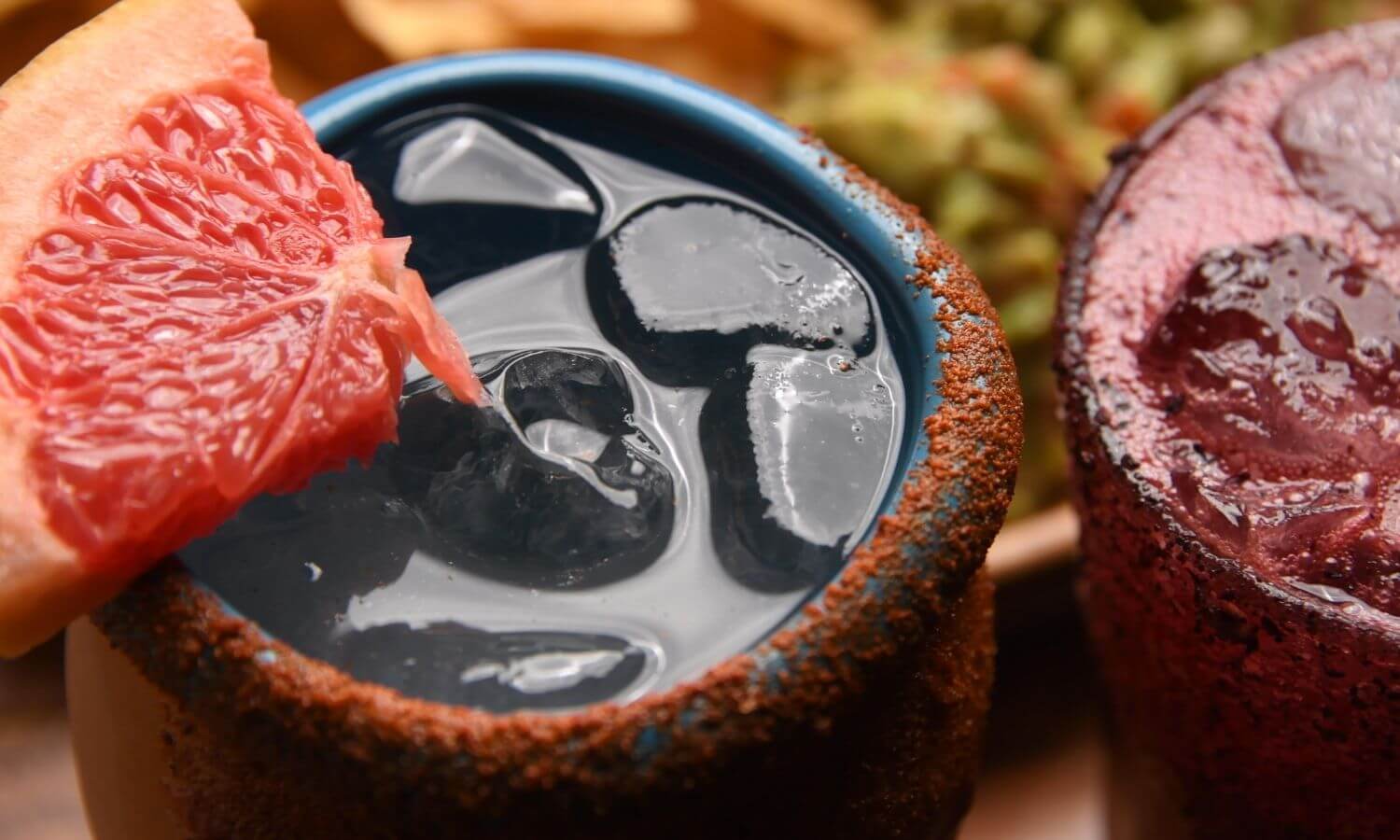
Sometimes this drink is served in a large earthenware casserole dish, in which case it´s called a “Cazuela” and you drink it with a straw! If you get the chance, there is no better place to drink a Cantarito or a Cazuela than the Plaza de Los Mariachis in Guadalajara. Of all the tequila cocktails, this may be my favorite.
Mezcal
Mezcal, often dubbed the “elixir of the gods,” traces its roots back to the indigenous peoples of Mexico. Predating the Spanish conquest, the spirit’s name is derived from the Nahuatl words “metl” and “ixcalli”, which together mean “oven-cooked agave”. It is believed that the indigenous Zapotec people of Oaxaca were among the first to produce this distilled spirit.
Like, Tequila, Mezcal has a Denomination of Origin (DOO) designation, which means it must adhere to specific production standards and can only be produced in designated regions to be officially recognized as mezcal.
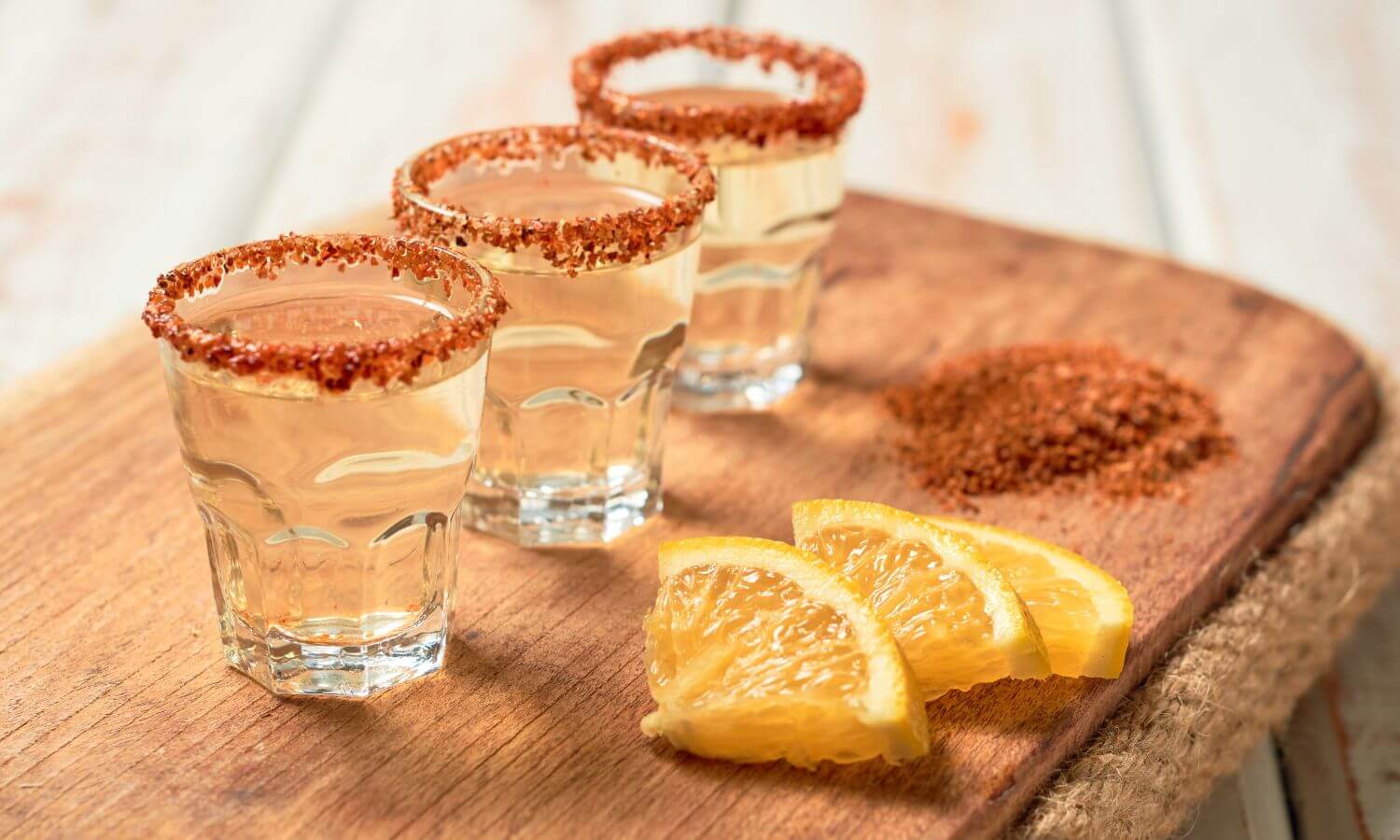
Unlike tequila, which is distilled only from blue agave, mezcal can be produced from various types of agave plants. The process begins with the harvesting of the agave’s core, or “piña”. These piñas are roasted in earthen pits lined with volcanic rocks, giving mezcal its signature smoky flavor. After roasting, the agaves are crushed, fermented, and then distilled, often in traditional clay or copper pot stills.
The mezcal industry has seen exponential growth, with both large-scale producers and small, family-owned palenques entering the market to meet the global demand. Efforts are underway to preserve its traditional production methods, ensuring that mezcal retains its unique character and cultural significance for generations to come.
Drinks with Mezcal
Mezcalita
The Mezcalita is essentially a twist on the classic Margarita, swapping out tequila for mezcal. This cocktail combines the smoky notes of mezcal with fresh lime juice and Cointreau or triple sec. It’s often served in a salt-rimmed glass and can be garnished with a slice of lime or even a chili pepper for added kick.
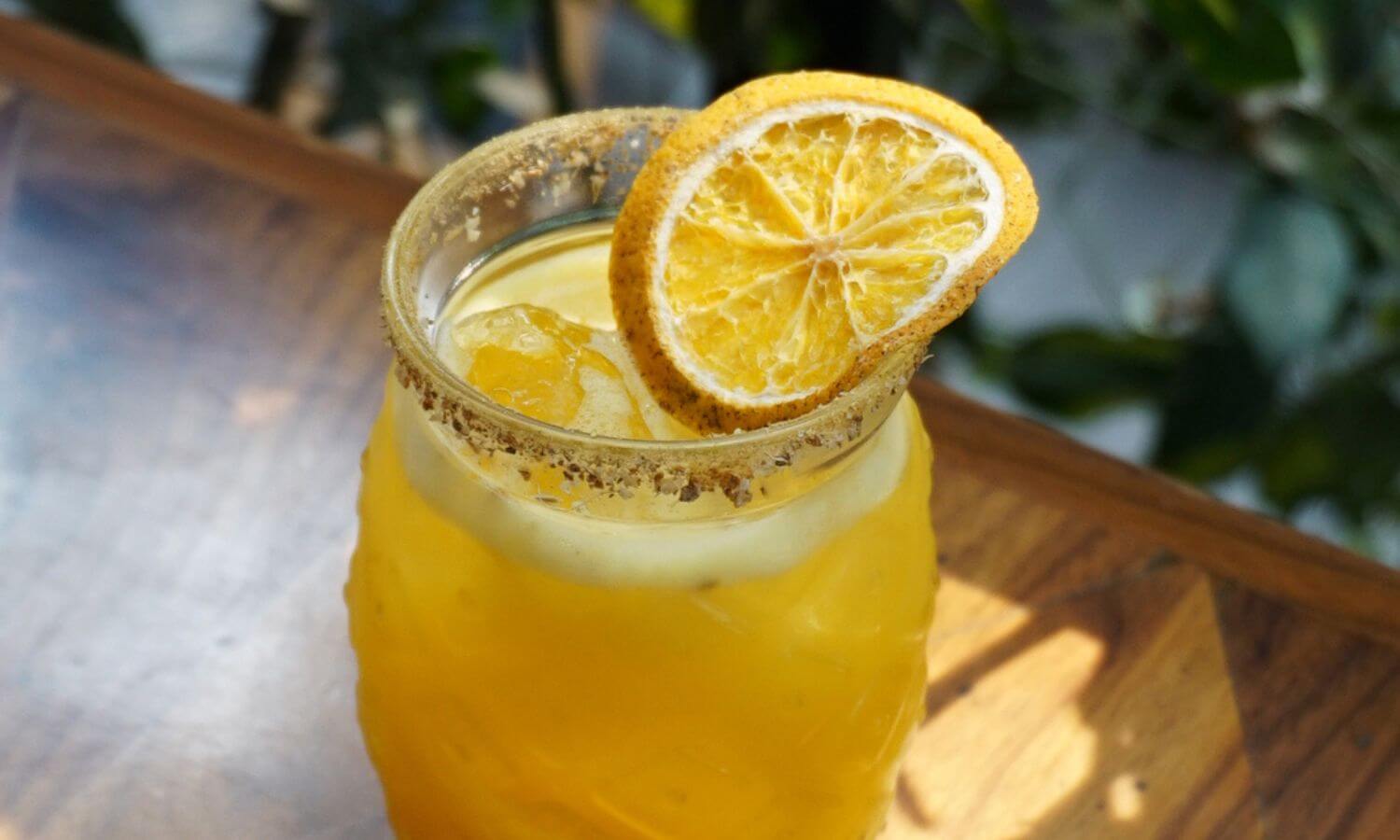
The smokiness of the mezcal juxtaposed with the tangy citrus makes it a refreshing choice. This is one of the most authentic Mexican drinks that you can order.
Mezcal Mule
Inspired by the Moscow Mule, the Mezcal Mule blends the smoky flavor of mezcal with the sharpness of ginger beer. To make, mix mezcal with fresh lime juice, and top off with ginger beer.

It’s usually served in a copper mug, garnished with a lime wedge or wheel. The spiciness of the ginger beer amplifies the unique characteristics and the smokey flavor of the mezcal.
Mezcalini
A fusion of mezcal and the classic Martini, the Mezcalini is a sophisticated cocktail that showcases the versatility of mezcal. This chic Mexican cocktail blends smokey mezcal with ingredients like agave nectar, fresh citrus juices, hibiscus tea, tamarind, fresh mint or even basil to add sweetness and complexity.
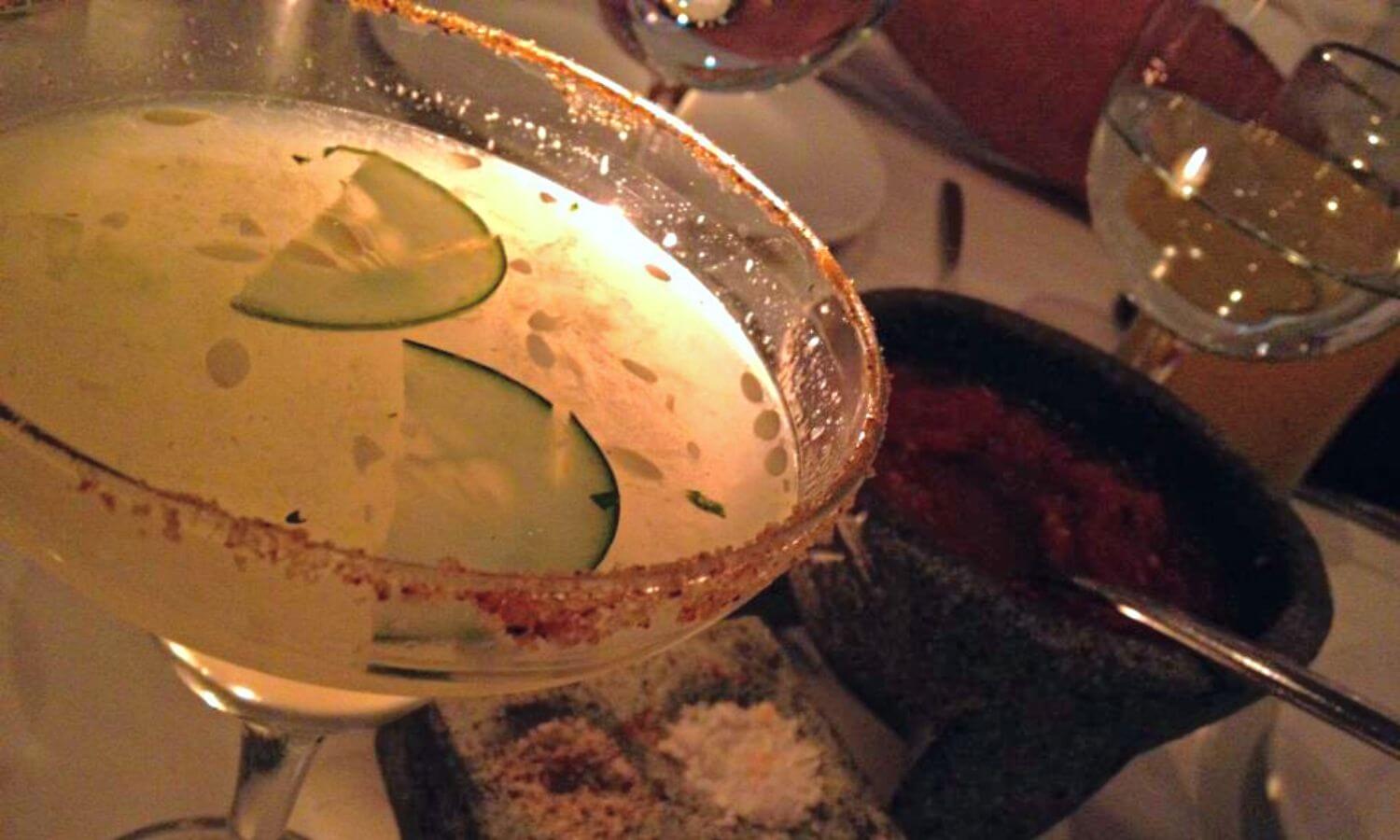
Served up or on the rocks and garnished with a twist of citrus peel or a slice of dehydrated fruit, the Mezcalini offers a refined way to enjoy the rich flavors of mezcal.
Other Agave-Based Spirits and Drinks
Sotol
Sotol is a distilled spirit from northern Mexico, primarily produced in the states of Chihuahua, Durango, and Coahuila. Made from the Dasylirion wheeleri plant, commonly known as the Desert Spoon, Sotol has been traditionally consumed by indigenous peoples for centuries. Unlike tequila and mezcal, which are made from agave, Sotol offers a unique, earthy flavor profile that reflects the arid landscapes where the plant grows.
The distillation process involves fermenting the plant’s core, called the “piña,” before distillation. Sotol can be sipped neat to appreciate its nuances, or used as a base in cocktails. It’s a less commercialized spirit, best sought out in specialty bars and liquor stores.
Raicilla
Raicilla(pronounced rye-SEE-ya) is a lesser-known distilled spirit, often referred to as “mezcal’s rebellious cousin.” Primarily produced in the state of Jalisco and the surrounding region, Raicilla dates back to the colonial period and was initially crafted as a local alternative to Spanish spirits.

Raicilla is obviously gaining in popularity as it went from being illegal, basically bootleg liquor to achieving a DOO status in 2019! Made from various types of agave plants, Raicilla is distinguished by its complex, floral notes and can vary greatly depending on where it is produced, the types of agave used and the specific distillation process. Raicilla is traditionally consumed neat to allow enthusiasts to appreciate its unique bouquet of flavors.
Sisal
Sisal as a distilled spirit is less well-known compared to its more famous counterparts like tequila and mezcal. Also called “Aguardiente de Henequen” it is made predominantly in the Yucatan from the sisal agave. Sisal is known primarily for its fibers which fueled the Henequen industry in the early 1900s.
Like other agave spirits, the heart of the sisal plant, or “piña,” is cooked, fermented, and then distilled to produce the spirit. Sisal’s flavor profile tends to be earthy and robust, reflecting the hardy nature of the plant itself. Unlike Tequila, which has strict production regulations, Sisal does not yet have a Denomination of Origin, making its production less standardized and allowing for regional variations.
Bacanora
Bacanora (pronounced bah-cah-NOR-ah) is a distilled liquor native to the state of Sonora, Mexico. It is made from the cooking, fermentation and distillation of agave.
Like Tequila, Mezcal, Sotol and Raicilla, Bacanora is an alcoholic beverage protected by denominations of origin meaning it can only be labeled Bacanora if it is produced within 34 specific municipalities in Sonora. This drink is obtained from the Angustifolia Haw type agave, more commonly known as Espadin. It is generally a clear, colorless drink with a high alcohol content, varying between 38% and 55% alcohol volume.

Lechuguilla
Lechuguilla (pronounced leh-choo-GEE-ya) is a potent Mexican spirit distilled from the lechuguilla agave, native to the Chihuahuan Desert. Often considered a “cousin” to mezcal or tequila, this unique liquor offers a smoky, earthy flavor with herbal undertones.
Due to its traditional, artisanal methods of production, Lechuguilla is primarily found in the states of Chihuahua and Coahuila, where it has been consumed by locals for generations. While it’s less commonly found in mainstream bars or stores, those looking to experience this rustic spirit should visit local markets or specialty liquor stores in these regions.
Pox
Pox (pronounced posh) is a traditionally made Brandy with roots in the Mayan culture of Chiapas. Pox is distilled from the fermentation of piloncillo and corn native to Chiapas. Most of this product comes from the regions of San Cristóbal de las Casas and San Juan Chamula where it is still used to this day in religious ceremonies and healing rituals.

Today, there is some commercial production and bottling and it can be found (if you look hard enough) in specialty shops in Mexico such as La Europea. If you happen to on the Yucatan peninsula, there is a great place in Merida called “Posheria” that has a fantastic selection. Legend holds that Pox is what you need to mend a broken heart.
Pulque
Pulque (pronounced POOL-keh) is an ancient Mexican alcoholic beverage made from the fermented sap of the maguey plant, a type of agave. With roots extending back to the pre-Columbian era, it was historically consumed by Aztec priests and nobility. Primarily produced in the central states of Mexico, pulque has a milky appearance and a sour, yeasty flavor.
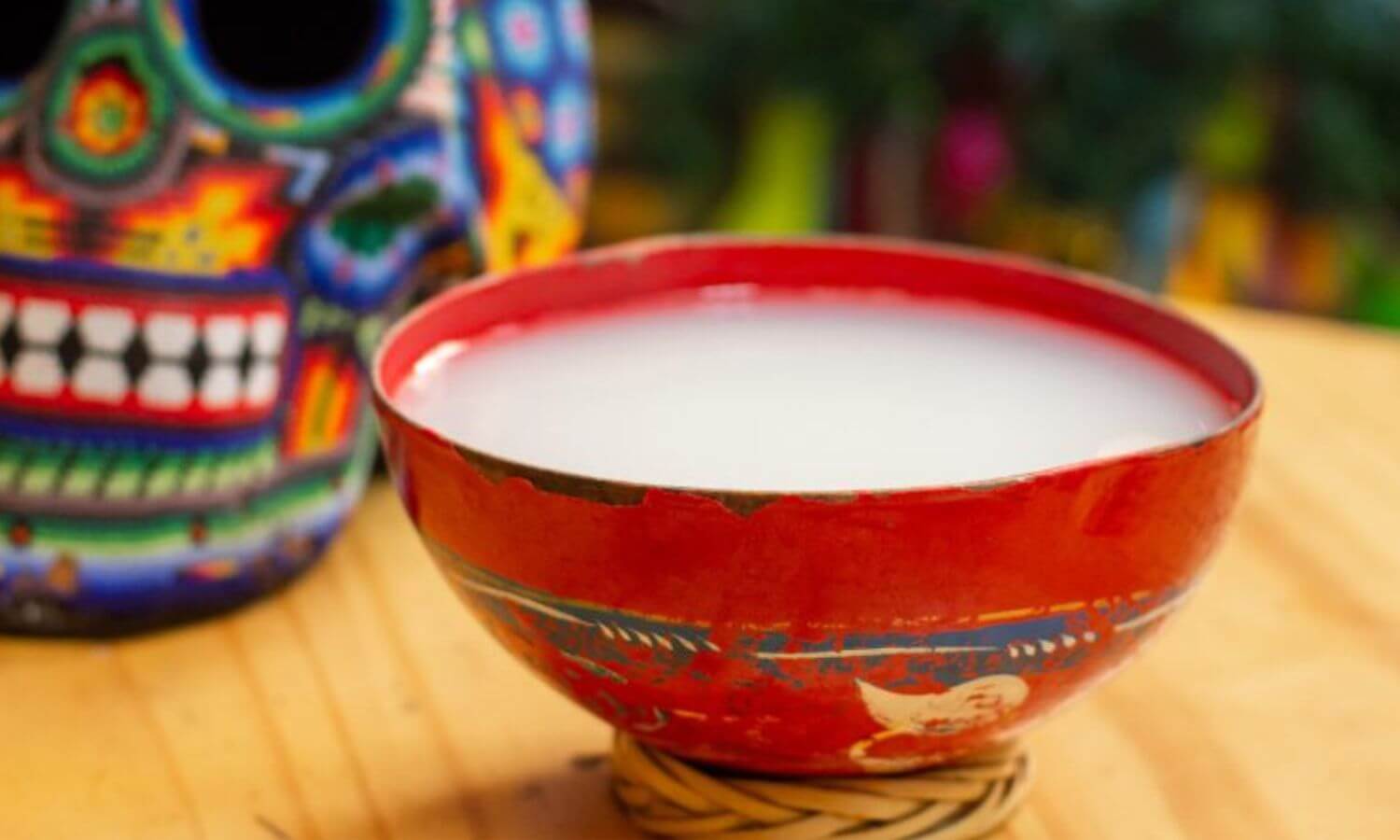
The drink is often consumed fresh due to its short shelf-life and is typically served chilled, either plain or flavored with fruits or spices. We carried plastic bottles of this ancient Mexican drink with us in the canoe during the Travasia Sagrada Maya.
Tepache
Tepache (pronounced teh-PA-che) is a fermented drink made primarily from the peel and the rind of pineapples, sweetened with piloncillo (unrefined cane sugar), and spiced with cinnamon or cloves. Sometimes referred to as “Pineapple Beer”, this slightly effervescent drink offers a perfect blend of sweet, tangy, and slightly spicy flavors.

Making Tepache is simple: combine pineapple rinds, piloncillo (unrefined brown sugar), and spices in a large jar, cover with water, and let it ferment for 2 to 3 days. Once fermented, strain the liquid and serve it chilled or over ice. Tepache can be served on its own or as a mixer with beer to kick up the alcohol content.
Charanda
One of the lesser-known alcoholic beverages native to Mexico, Charanda is a typical brandy made from sugarcane and certain grains found in the state of Michoacán. The production process is similar to that of rum. Charanda can range in color from clear to amber. Aged Charanda, stored in oak barrels, takes on a richer flavor profile and color. Traditionally, Charanda is enjoyed neat, allowing aficionados to appreciate its nuanced flavors, which can include notes of vanilla, molasses, and toasted nuts. It can also be used as a base spirit in various cocktails such as “Charanda Punch” or “Charanda Sour,” and other mixed drinks which incorporate citrus fruits, sugar, and other local ingredients to complement the spirit’s natural sweetness.
Xtabentun
Xtabentún (pronounced esh-ta-ben-TOON) is a traditional liqueur from the Yucatán Peninsula, made from anise seed and fermented honey sourced from the xtabentún flower, a native morning glory. This aromatic spirit has Mayan roots and was initially consumed for ceremonial purposes. Modern production involves the blending of anise and honey with rum or neutral spirits. The liqueur has a sweet, floral, and slightly spicy profile, making it distinctively rich. Xtabentún is commonly sipped neat, used as a digestive after meals, or mixed with honey and lime for a refreshing cocktail.
Ancho Reyes
Hailing from the state of Puebla in Mexico, Ancho Reyes is a unique liqueur known for its spicy and sweet profile. There are two kinds of Ancho Reyes, Green and red.
The green “verde” is made from green poblanos which are roasted over an open flame, giving the liqueur a slightly smoky character combined with the fresh, grassy notes of the green peppers.

The red “rojo” is made from ripe poblano peppers that have been sun-dried until they become “ancho” chilies. Ancho Reyes Rojo has a deeper, more complex flavor with notes of dried fruit, cocoa, tamarind, and a smoky sweetness.
Ancho Reyes can be sipped neat to fully appreciate its complex flavors, but it truly shines as an ingredient in cocktails. Its unique blend of sweetness and heat makes it a versatile addition to a variety of base spirits, especially mezcal and rum, creating innovative cocktails that highlight its unique profile.
Rompope
Rompope is a traditional Mexican cream liqueur, similar to eggnog, that originated in the convents of Puebla, Mexico in the colonial period. Made from milk, sugar, vanilla, and egg yolks, the mixture is spiced with cinnamon and often fortified with rum or grain alcohol. Its creamy texture and rich, spiced flavor make it a popular Christmas drink, although I enjoy it year-round.
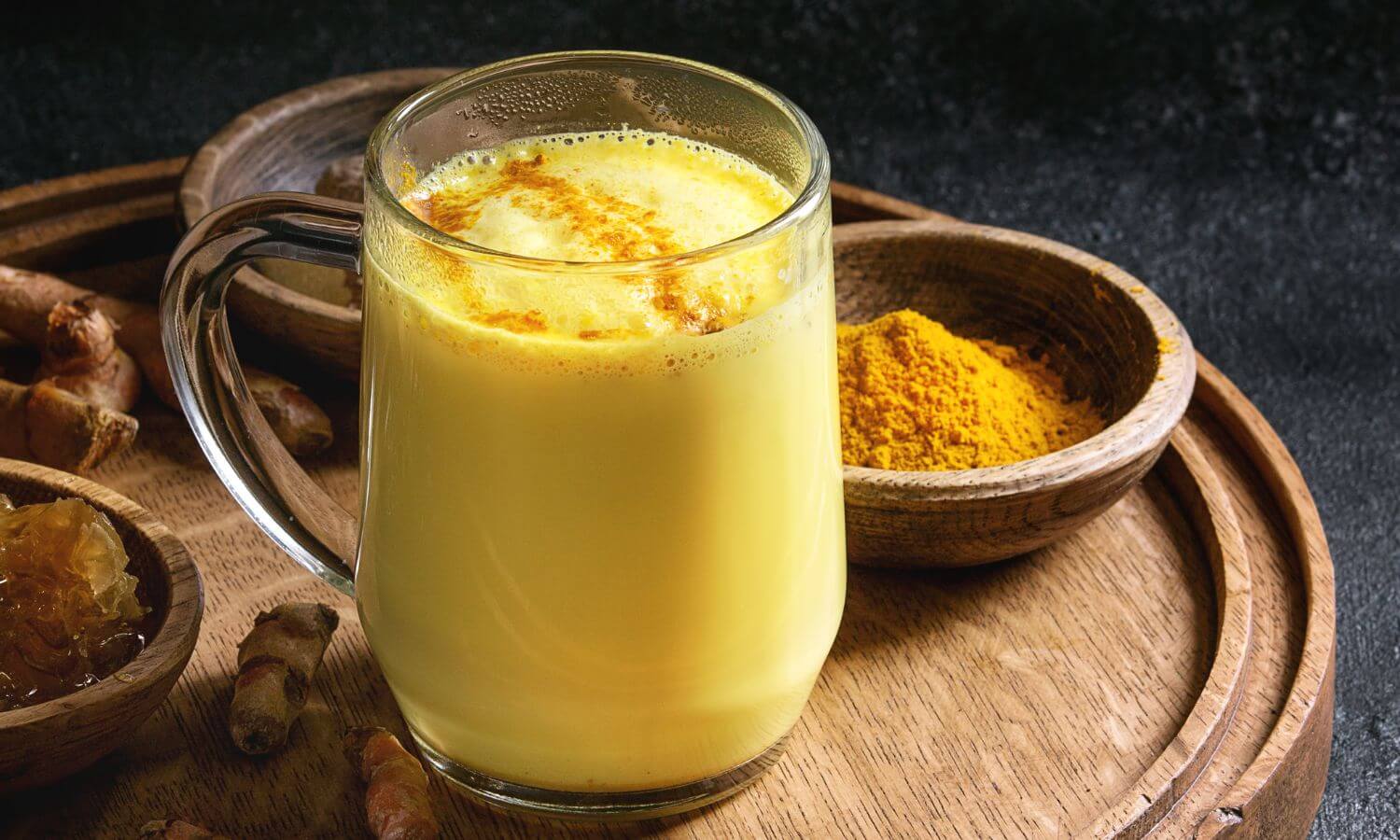
Typically consumed chilled and straight from a small glass, Rompope is a sweet drink that can also be used in desserts or as a creamer in coffee. The original recipe from Puebla remains the most famous, but variations are produced across Mexico and Central America. Kick it up another notch by pouring it over ice with some spiced rum!
Kahlua
Kahlúa is a world-renowned Mexican coffee liqueur, first produced in the 1930s in Veracruz. The name “Kahlúa” is derived from the indigenous Nahuatl language and means “House of the Acolhua people.” Made with Arabica coffee beans, sugarcane, and rum, Kahlúa offers a sweet, velvety texture combined with a rich coffee flavor and a hint of vanilla.

It can be enjoyed in various ways; sipped neat, on the rocks, or as a key ingredient in cocktails like the White Russian and the Espresso Martini.
Mexican Wine
Mexico’s viticultural history dates back to the Spanish conquest in the 16th century. Hernán Cortés, after arriving in the New World, ordered the planting of grapevines to produce wine for religious ceremonies. However, by the late 17th century, Spanish royalty, threatened by the burgeoning industry’s potential competition, severely restricted wine production in Mexico. For centuries, Mexican wine remained in the shadows.
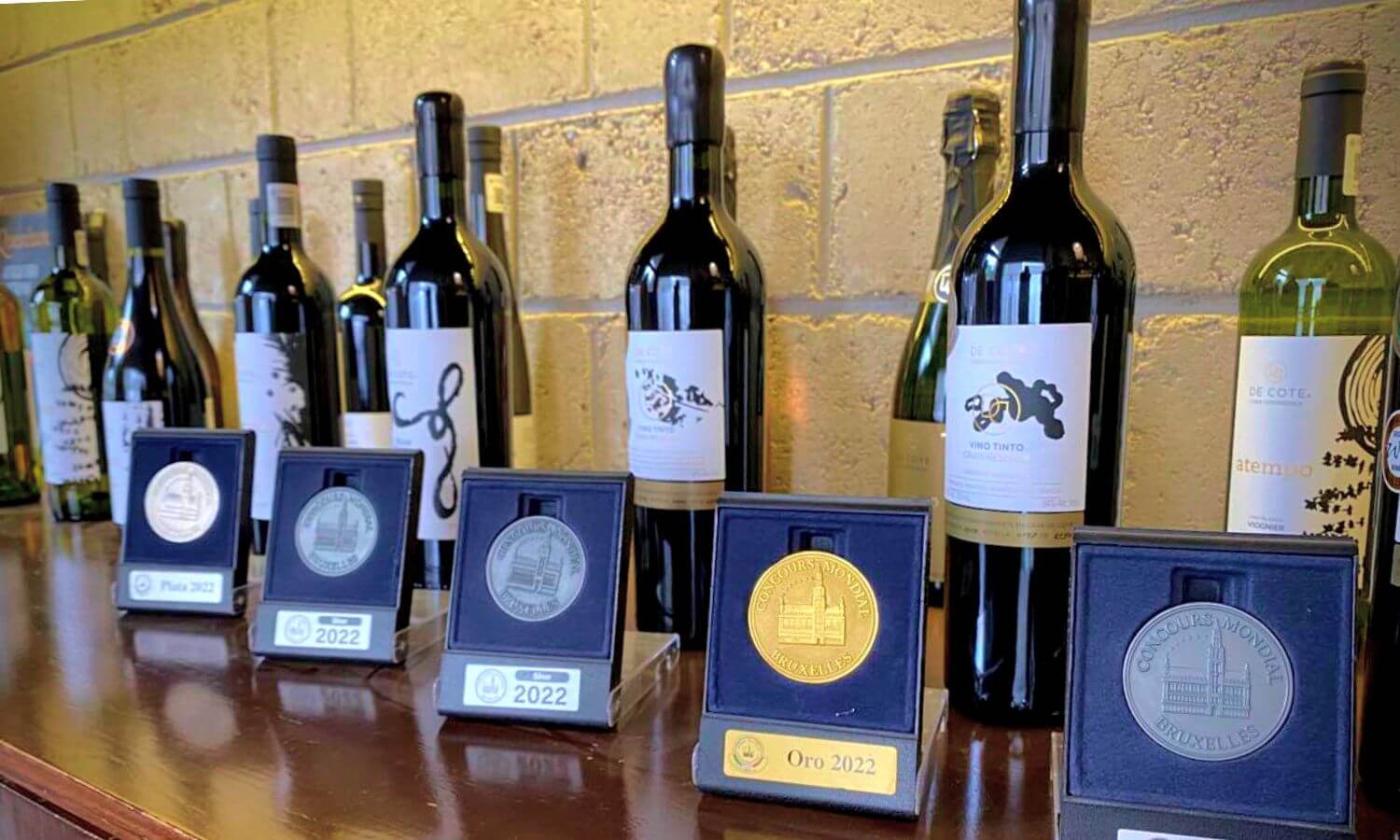
The revival of Mexican wine in the 20th century brought attention to its diverse wine regions. Valle de Guadalupe in Baja California is the most recognized, often dubbed the “Napa Valley of Mexico”. Its Mediterranean climate is ideal for grape growing, producing high-quality wines. Other significant regions include Parras in Coahuila, known for its old vines and high-altitude vineyards, and Queretaro, which dominates the country´s sparkling wine production.
Now there are many wine festivals throughout the year in Mexico.
Casa Madero holds the title of the oldest winery in the Americas, established in 1597 in Parras. With a rich history and dedication to quality, it’s a standard-bearer for Mexican wine. Other notable wineries include Monte Xanic, a pioneer of the modern Mexican wine movement, and L.A. Cetto, one of the country’s largest and most acclaimed producers. El Cielo and Decantos Vinícola are among the newer establishments making waves in Valle de Guadalupe with many more on the way.
Mexican Drinks Made with Wine
Tinto de Verano
With origins in Spain, Tinto de Verano has gained widespread appreciation throughout Latin American countries including Mexico. Literally translating to “Red Wine of Summer,” Tinto de Verano is a refreshing beverage that captures the essence of relaxed summer days.
To make a Tinto de Verano, simply combine a fruity red wine with a citrus-flavored soda and serve it in a large wine glass with lots of ice. This is one of my favorite things to drink in Mexico and I make it with red wine and Fresca with a squeeze of lemon.
Clericot
Clericot (pronounced clair-ee-COT) is a Mexican cocktail that is similar to sangria and has roots in the French drink “claret”. Made by combining red or white wine with a medley of chopped fruits like apples, oranges, and berries, it often includes a touch of brandy or rum for an extra kick.
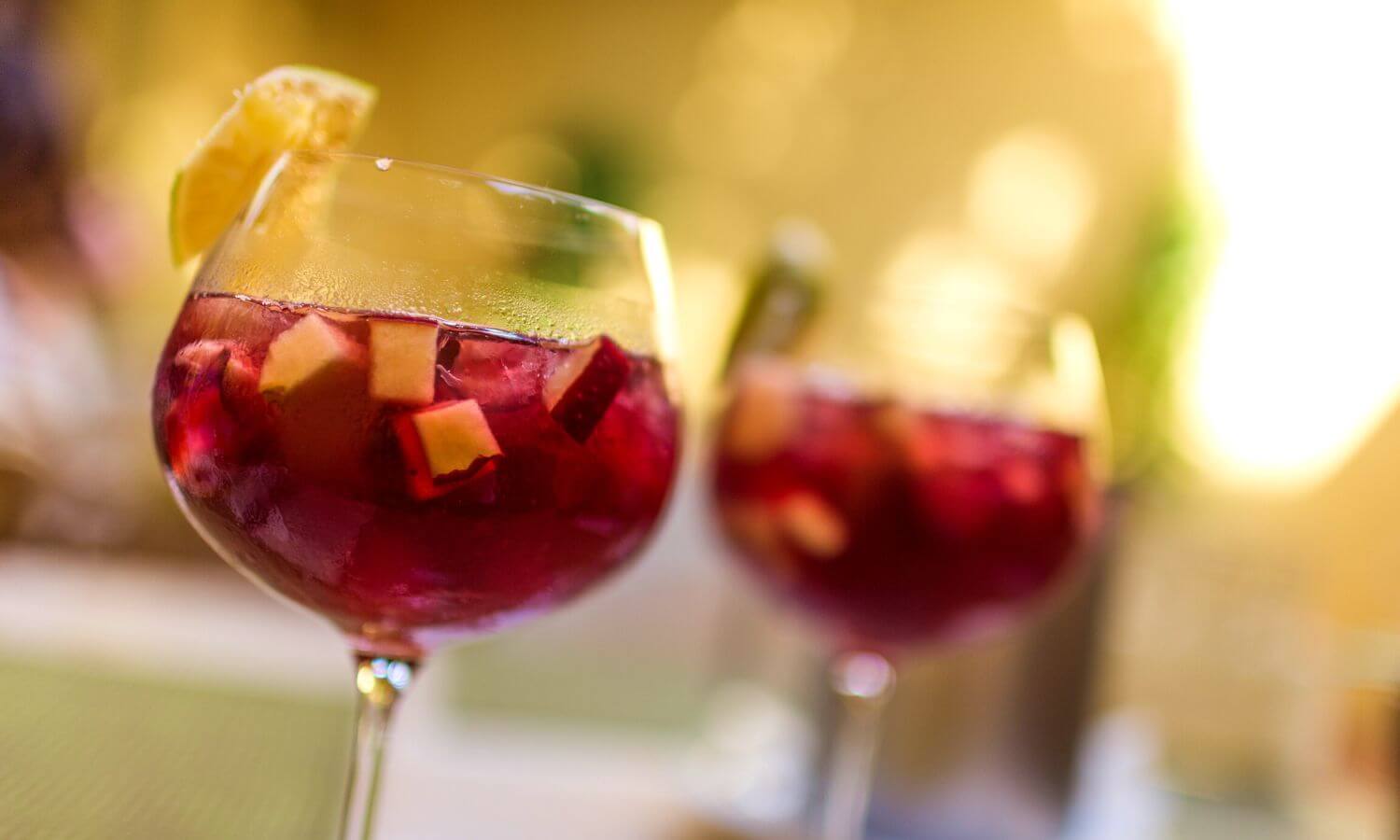
While it’s not as historically ingrained as other Mexican drinks, Clericot has become a popular choice for social gatherings and festive occasions in Mexico. It’s typically served chilled in large pitchers or bowls, allowing the fruits to soak in the wine. Enjoy it in a wine glass, scooping some of the alcohol-infused fruit into each serving.
Mexican Beer
Mexico boasts a rich history of beer production, rooted in traditions that have withstood the test of time. Today, the country is recognized both for its iconic, globally-beloved brands and a burgeoning craft beer movement. Many Mexico beers are now household names not only in Mexico but in the United States and across the globe. Corona, Tecate, Pacifico, Dos Equis, Modelo and Bohemia are some of the powerhouse beer brands that have put Mexico on the map as a beer producer and exporter. In 2023, Mexico’s Modelo Especial became the best-selling beer in the U.S., dethroning Bud Light, which held the top spot since 2001.

In recent years, Mexico has witnessed an explosion in its craft beer scene. Cities like Tijuana, Oaxaca, Ensenada, and Mexico City have become hubs for microbreweries pushing the boundaries of flavor and style. Some of the up-and-coming artisanal beer producers to look for are Baja Brewing, Cerveza Minerva, AquaMala Cerveza Artesanal, Cerveza Urbana, Rámuri, Cerveza Fauna and Bocanegra. I guarantee these brews will rival any craft beers in the US.
Popular Mexican Beer Drinks
Chelada
Chelada is a refreshing Mexican beer drink that’s incredibly simple but packs a punch of flavor. The basic version consists of light beer (Sol, Corona, Tecate) mixed with fresh lime juice, served in a salt-rimmed glass filled with ice. The drink is part of the “beer cocktail” family in Mexican culture, which also includes more elaborate concoctions like the Michelada. The Chelada is a popular choice in bars, beach fronts, and even family gatherings across Mexico. This is the perfect drink to cool you down on a hot summer day.
Michelada
The Michelada is perhaps the most iconic Mexican beer cocktail. Sometimes described as a Mexican Bloody Mary with beer, it features a blend of lime juice, assorted sauces like Salsa Inglesa (Worcestershire Sauce), Jugo de Magi and Tabasco and spices like chili and salt, mixed directly into a glass of beer with lots of ice.
The rim is typically salted or rimmed with a seasoning such as chili powder or Tajin. The result is tangy, spicy, and incredibly refreshing. Every bartender seems to have their own recipe for Michelada so if you like yours prepared a certain way, ask before ordering.
Ojo Rojo
Translating to “Red Eye,” this drink combines beer with Clamato juice and a bit of hot sauce and other seasonings. It is served over ice in a glass with a salted rim and often garnished with a lime wedge and sometimes even a shrimp or two in you are feeling fancy.
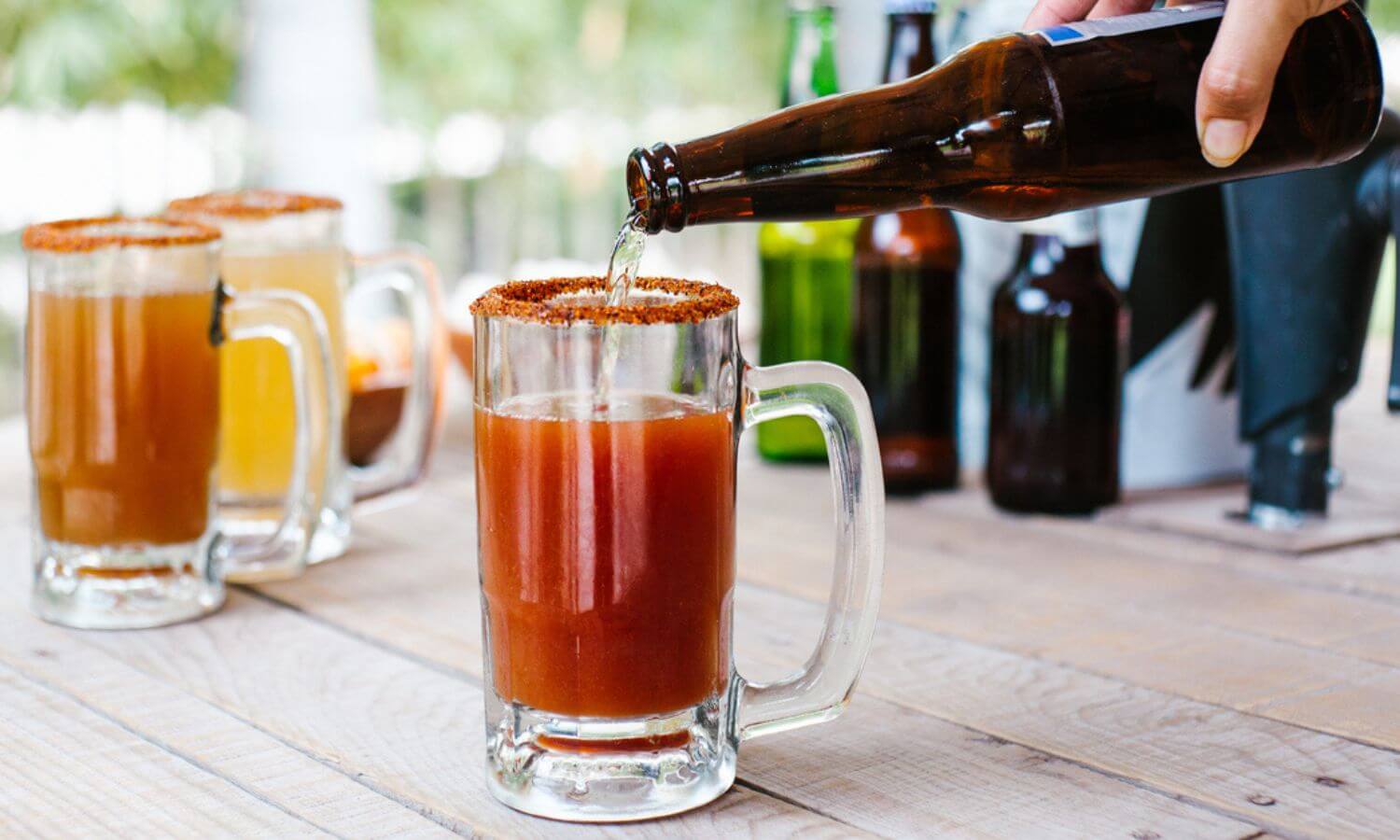
Many people describe an Ojo Rojo as a Michelada with Clamato juice but I make mine more like a Bloody Caesar with beer. This is my favorite hangover cure. If you can find it Clamato “Cubano” makes the best Ojo Rojo!
Chamochela
A Chamochela is a creative fusion of a traditional Michelada and a Chamoyada. This Mexican beer drink combines the refreshing qualities of beer with the tangy, spicy, and sweet flavors of salsa chamoy and often includes elements like shaved ice, lime juice, and chili-lime seasoning like Tajín.
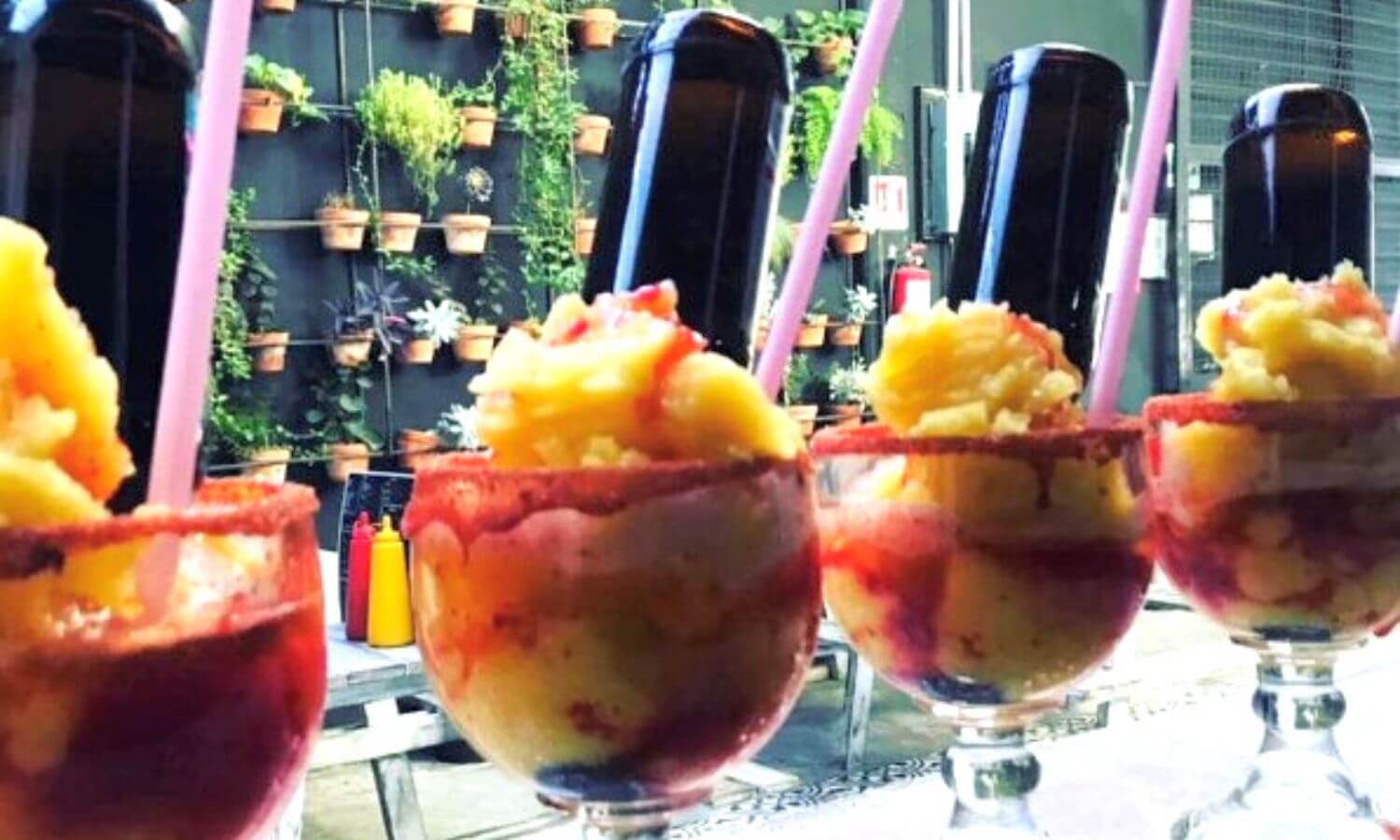
Imagine sipping a cold beer through layers of sweet, spicy, tangy chamoy and icy slush, punctuated by the zest of lime and a hint of spice. It is a unique and exhilarating beverage perfect for festive occasions or hot summer days.
Gomichela
A Gomichela is a playful and colorful twist on the Chamochela. In addition to the classic ingredients of lime juice, salt, chamoy sauce and assorted spices, the Gomichela features an unexpected yet delightful element: gummy bears, gummy worms and other sweet treats. These chewy, sugary treats are used to garnish the drink, infusing it with a fruity sweetness that complements the spiciness and tang of the other ingredients.
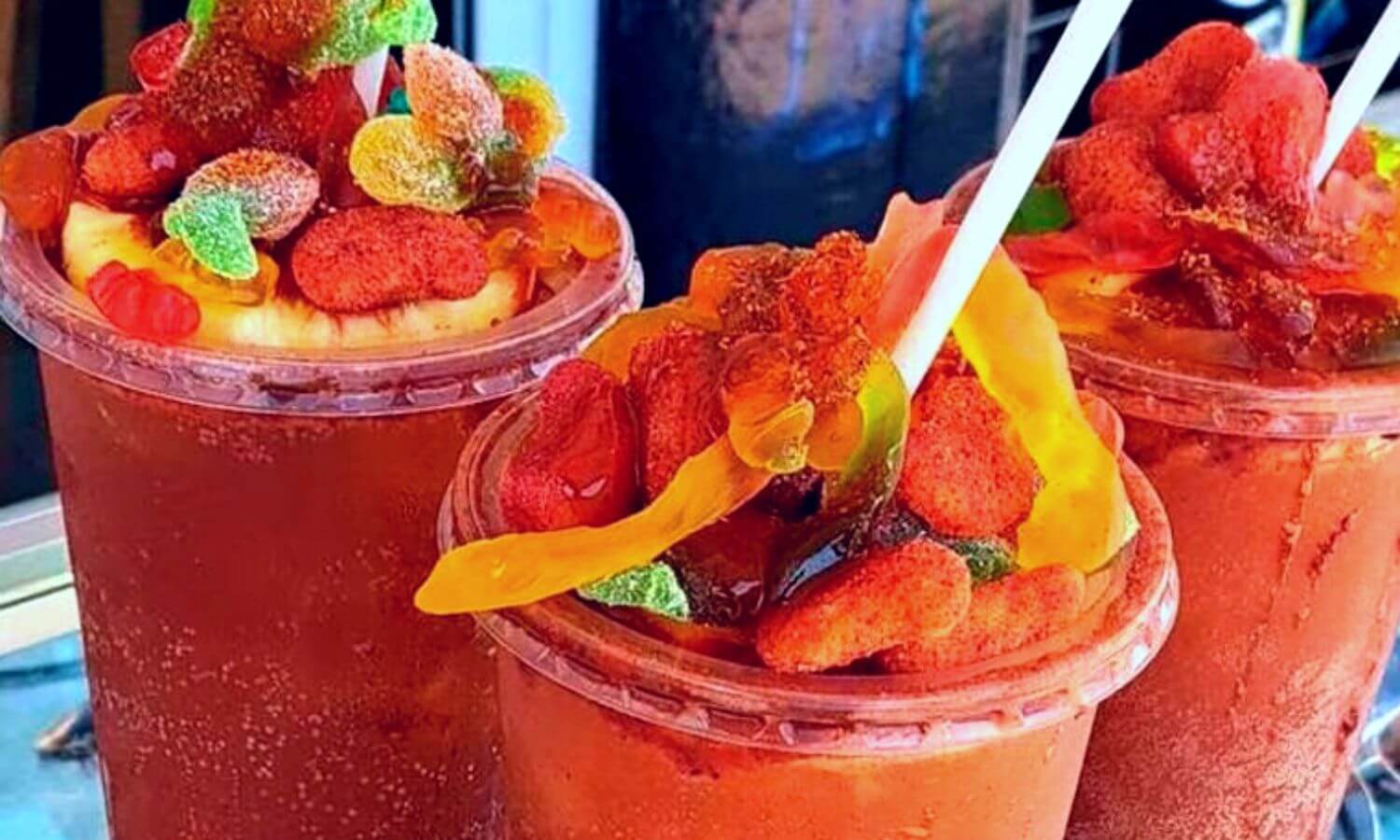
This vibrant concoction puts a fun, youthful spin on the classic Chamochela. The best place to try a Gomichela? The Tepito neighborhood in Mexico City is famous for them!
Coronarita
A playful fusion of a Corona beer and a Margarita, the Coronarita involves serving a small bottle of Corona upside down in a large glass of Margarita with lots of ice cubes, allowing the beer to mix with the Margarita as you drink it. It’s a fun, interactive experience that’s become popular at many Mexican bars and restaurants and it really hits the spot on a hot day.
Where is the best place to enjoy this refreshing drink? You can find them all over Mexico but my favorite place for a Coronarita is on the shore in Campeche City while enjoying fresh seafood straight out of the Gulf of Mexico.
Carajillo
The Carajillo (pronounced cah-rah-HEE-yo) is a sophisticated Mexican cocktail that combines the robust flavors of espresso with the sweet and herbal notes of Licor 43, a Spanish liqueur. This drink has gained popularity for its simplicity and the magical way it balances bitterness and sweetness.

To make a Carajillo, simply pour 1.5 ounces of Licor 43 into a glass, then freshly brew a shot of espresso over it. My favorite version involves blending the ingredients with ice in a cocktail shaker to create a frothy layer on top. Order this chic Mexican drink with or in place of dessert after a nice dinner out and impress all your Mexican friends!
Delicious Must-Try Non-Alcoholic Mexican Drinks
Horchata
Horchata (pronounced or-CHA-tah) is a sweet, refreshing Mexican drink made from white rice and flavored with ground cinnamon, and Mexican vanilla. This creamy, non-dairy beverage is a staple in taquerias and Mexican restaurants, often served chilled to complement spicy foods. Though you’ll find excellent Horchata all over Mexico, it’s especially beloved in the Yucatán Peninsula where it might include local spices or fruit.
The creamy freshness of horchata makes a great beverage to complement Mexican food like carnitas tacos and especially kastakan. These days, a lot of places serve Horchata made from concentrate. If you can find an eatery that is making it from scratch, you know you are in the right place!
Aguas Frescas
Aguas Frescas (which translates literally to “fresh waters”) are a popular drink all over Mexico and can be found served in homes, mercados, taquerias, restaurants and from street vendors. Aguas Frescas are made by thoroughly blending fresh fruit with water and then passing the liquid through a fine mesh strainer or sieve. The remaining clear liquid is then sweetened to taste and more water is added to achieve the desired consistency. The result is like a fresh, watered-down juice. Aguas Frescas are a great alternative to sodas and soft drinks, especially for children.

Some of the most popular Aguas Frescas are watermelon, mango, cucumber and mint, lime, melon, strawberry and papaya. Aguas Frescas are easy to make at home and one of the best Mexican drinks to serve your guests on a hot day.
Agua de Jamaica
Jamaica (pronounced ha-MY-kah) is a popular Mexican “agua fresca”, made like a tea from dried hibiscus flowers. This ruby-red beverage is both tart and sweet, often enjoyed chilled with a splash of lime and a sprinkle of sugar. This hibiscus tea is a traditional Mexican drink and a quintessential thirst-quencher, especially loved for its vibrant color and refreshing taste. You’ll find excellent Jamaica at street stalls, markets, and taquerias throughout Mexico and all across Latin America.
Agua de Tamarindo
Unlike some of the simpler Aguas Frescas, making Agua de Tamarindo is a more laborious process. You start by peeling the tamarind pods, and removing the hard outer shell to expose the sticky, brown pulp inside. Boil for about 15 minutes or until the tamarind pulp softens. Allow the liquid to cool a bit and, using your hands, continue to separate the pulp from the seeds.
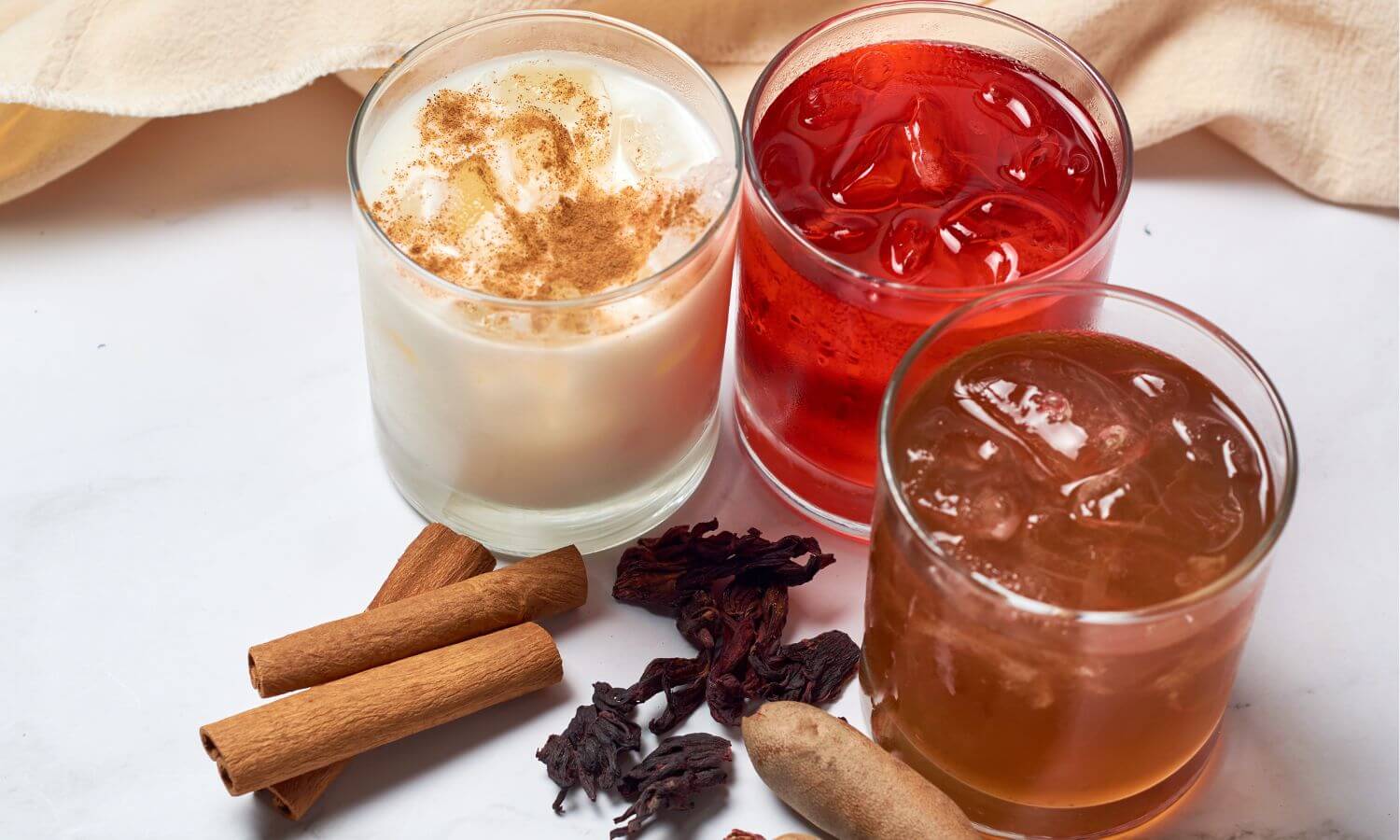
Strain the mixture into a pitcher or bowl, pressing the pulp to extract as much juice as possible. Add brown sugar to the tamarind concentrate and stir well until completely dissolved and add more water until the consistency is as you like it. Authentic Agua de Tamarindo is one of the most traditional drinks in Mexico and well worth the effort to try.
Agua de Chilacayote
Agua de Chilacayote (pronounced chee-la-kai-YO-teh) is a traditional Mexican drink made from chilacayote, a type of smooth-skinned, sweet-tasting squash. The drink combines boiled chilacayote pulp with raw cane sugar (piloncillo) and cinnamon for flavor. Originating in pre-Hispanic times, it was a way to make use of all parts of the chilacayote plant. The drink has a subtle sweetness balanced by earthy, spicy notes.
To prepare, the squash is cooked until soft, then the flesh is scooped out, shredded, and boiled with the spices and sugar. Agua de Chilacayote can be found in local markets or at street food stands in various parts of Mexico, but it is very popular in Oaxaca.
Tejate
Tejate (pronounced teh-HA-teh) is a traditional Oaxacan beverage with roots dating back to pre-Hispanic times. Often referred to as the “drink of the gods,” this complex concoction is made from a unique blend of ingredients including maize (corn), cacao beans, mamey seeds, and flor de cacao (also known as rosita de cacao).
These ingredients are ground into a paste, which is then mixed with water and served cold. The result is a frothy, aromatic drink that has a nutty, chocolaty flavor profile with slightly floral undertones. Consumed mainly in Oaxaca and its surrounding regions, Tejate is more than just a drink; it’s a cultural symbol that carries the rich history of the indigenous Zapotec and Mixtec peoples.
Pozol
Pozol (pronounced po-ZOAL and not to be confused with “Pozole” the delicious hominy-based soup) is a traditional Mexican beverage with origins among the indigenous people of the country, particularly in the southern states of Chiapas and Tabasco. Made from fermented corn dough and often flavored with cocoa, Pozol is both nutritious and deeply rooted in cultural history.
It is typically consumed cold and serves as a thirst-quencher, especially in the hot climates of southern Mexico. This non-alcoholic beverage is versatile, with variations including sweetened and unsweetened versions, and some even spiced with a touch of chili. You can find Pozol sold by street vendors all over Mexico and in Latin American neighborhoods in the US.
Tejuino
Tejuino (pronounced teh-HWEE-no) is a fermented corn-based beverage that hails from the state of Jalisco, Mexico. This traditional drink has been enjoyed for centuries and is especially popular among the indigenous Huichol people. Made by fermenting masa (corn dough) with water and piloncillo (unrefined cane sugar), Tejuino has a mildly sour, slightly sweet taste. It’s typically served cold, over shaved ice with a squeeze of lime or a sprinkle of salt. The beverage is not only refreshing but also deeply connected to regional traditions.
Tascalate
Tascalate (pronounced tas-kah-LAH-teh) is a distinctive Mexican drink originating from the southern state of Chiapas. It is a unique blend of ingredients like toasted maize (corn), cacao, achiote, vanilla, and cinnamon or other spices. The ingredients are ground into a powder, which is then mixed with either water or milk to create a rich, earthy beverage.
Tascalate stands out for its vibrant orange-red hue, derived from the achiote, and its complex flavor profile that’s simultaneously sweet, nutty, and spicy. This non-alcoholic beverage is most often consumed cold but also enjoyable as a hot beverage. Tascalate is considered a natural energizing drink and is often served in the early afternoon as a pick-me-up.
Limonada
One of the simplest and most popular non-alcoholic Mexican drinks, a Limonada is nothing more than freshly squeezed lime juice mixed with fresh water and sweetened to taste with sugar, honey or agave syrup. A Limonada can be made “natural” with still water or “mineral” made with sparkling soda water. Some popular variations on this drink are Naranjada (made with freshly squeezed oranges) Piñada (made with pineapple juice) and Mangonada (with mango juice). Other ways to kick up your Limonada game are by adding Chia Seeds, fresh mint or a splash of pomegranate juice.
Chamoyada
In essence, a Chamoyada is a celebration of contrasting flavors and textures, making it a favorite among those who enjoy a harmonious blend of sweet and spicy treats. The base of a Chamoyada is shaved ice or a fruit-flavored slush. Mango and tamarind are two of the most popular flavors. Chamoy, a tangy, sweet, and spicy sauce is generously drizzled over the slush, giving the chamoyada its name and its distinctive flavor.

The drink is then sprinkled with a spicy chili seasoning like Tajin. You can stop there or add your choice of tamarind candy, chunks of fresh fruit, gummy candies and other sweet treats. This fantastic concoction is generally presented with a large straw and a spoon to get at all the goodness! A Chamoyada is truly a fun non-alcoholic drink that is quintessentially Mexican.
Jarritos
Jarritos is a beloved Mexican soda brand founded in 1950, known for its wide array of fruit-flavored carbonated beverages or refrescos. You can choose from Tamarind, Mandarin, Fruit Punch, Jamaica, Lime, Grapefruit, Guava, Pineapple or Strawberry. Each flavor offers a vibrant, authentic taste experience that pairs excellently with Mexican cuisine so much so that Jarritos is referred to as ”The Official Drink of Tacos¨.

What sets Jarritos apart is its use of natural sugar cane (like Mexican Coke) and real fruit flavors, providing a more genuine and less artificially sweet taste compared to many other sodas. Its popularity has transcended borders, becoming a staple in Mexican family-run restaurants and grocery stores worldwide, making it not just a drink, but a cultural icon. My favorite is Pineapple!
Sangrita
My favorite way to enjoy good tequila is not as a shot, but sipped slowly with Sangrita on the side. Sangrita, which translates to “little blood”, is the traditional Mexican accompaniment to high-quality tequila, meant to be sipped alternately, not mixed with it. This vibrant, slightly citrusy concoction enhances the complex flavors of tequila.

Typically made from a blend of tomato juice (not Clamato or V8), orange juice, a squeeze of lime, and a splash of hot sauce for spice. The bright red color is achieved with a splash of grenadine which also helps to balance the sweetness with the savory, spicy notes. Every bartender has their own secret recipe (including me) so expect the flavor to be a little bit different from place to place.
Mexican Drinks to Warm the Heart and Soul
Ponche
Originating from the state of Veracruz, Ponche is a warm, spiced beverage with roots in both Spanish and indigenous cultures. Made with a blend of fruits like guava, apple, and tejocotes (Mexican hawthorn) and a variety of spices like cinnamon and clove.
Ponche or Ponche de Frutas is commonly consumed during the holiday season, particularly during Las Posadas, a nine-day celebration leading up to Christmas. Served warm, it is delicious on its own but can be “kicked up” with the addition of Rum or Brandy. Ponce brings families together, offering a cozy, festive drink that embodies the spirit of the holidays.
Café de Olla
Cafe de Olla (pronounced cah-fe dey OY-ya) is a traditional Mexican coffee prepared in a large clay pot usually over an open fire, which lends a unique, earthy flavor. Rooted in the Mexican Revolution, it was initially made by soldiers using simple, available ingredients.

The brew combines ground coffee with cinnamon sticks and piloncillo, a type of unrefined cane sugar, offering a sweet and spiced flavor profile. To make Café de Olla, water is brought to a boil in a clay pot, then cinnamon and piloncillo are added until dissolved. Coffee grounds are then added to the mixture and steeped before straining and serving.
Atole
Atole is a traditional Mexican hot drink made from masa harina (corn dough), water or milk, and flavors like cinnamon, vanilla, or chocolate (in which case it’s called a “Champurrado”). This creamy, comforting beverage is often enjoyed with tamales and is a staple during festivities like Dia de Los Muertos and Christmas.

During the winter months, it’s commonly found in holiday markets but is also still made in many Mexican homes. Atole is a must-try for anyone looking to experience the warmth of Mexican hospitality.
Champurrado
Champurrado (pronounced cham-poor-RAH-do) is a rich, warming Mexican drink that’s essentially a fusion of Mexican hot chocolate and the traditional maize-based beverage, Atole. Infused with cinnamon and sometimes anise, its smooth velvety texture is achieved by using corn flour as a thickener.
Champurrado is especially popular during the winter and at festive occasions like Las Posadas and Day of the Dead. You can also find it in Mexican bakeries and restaurants, often paired with churros or tamales.
Mexican Hot Chocolate
On cold days, there is nothing better to warm the soul than authentic Mexican Hot Chocolate. The main ingredient is Mexican chocolate which is broken into pieces and allowed to melt in warm milk. To this, you add a little sugar or piloncillo, ground cinnamon, nutmeg and a pinch of cayenne pepper. The concoction is then whisked thoroughly with a special utensil called a molinillo until it is light and frothy.
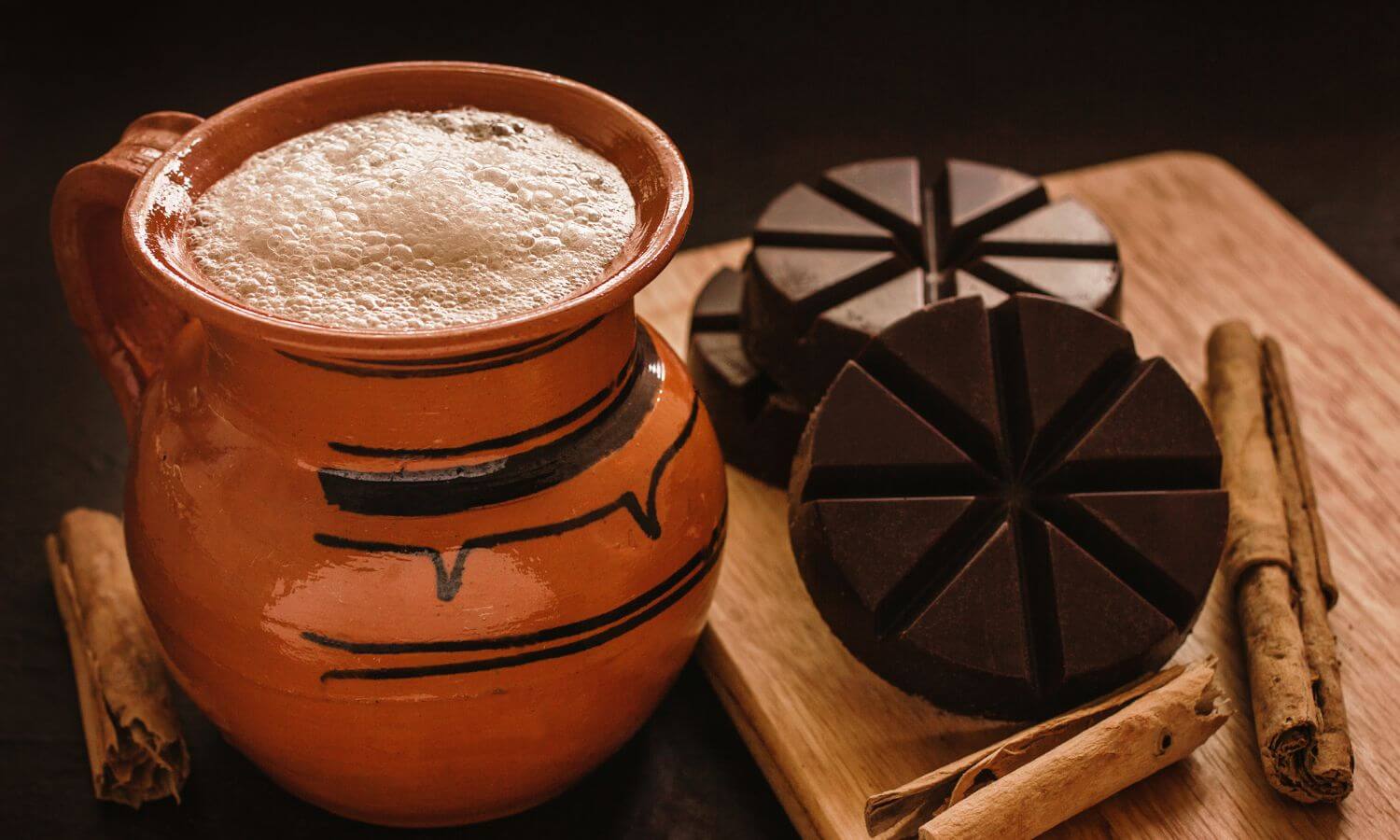
So now you know what to drink in Mexico!
Exploring traditional Mexican drinks provides an interesting view into the nation’s history and cultural practices. From ancient beverages like Pulque to popular modern cocktails like the Mezcalini, the wide variety of Mexican drinks showcases Mexico’s diverse history, landscape and culinary traditions. As global interest in Mexico grows, traditional Mexican drinks offer outsiders a sip of the country’s past and a taste of its promising future. If you liked this list, you may also like to read 41 Things to Get in Mexico: The BEST Mexico Souvenirs

